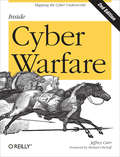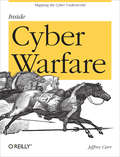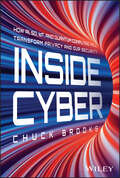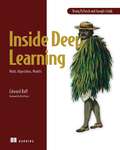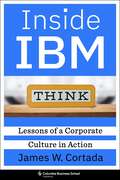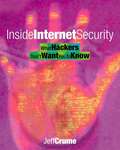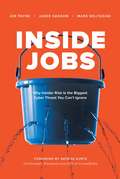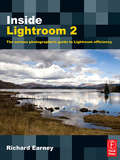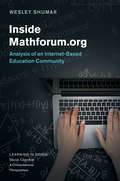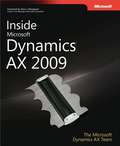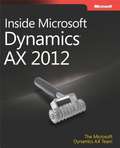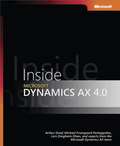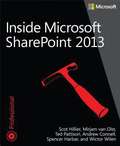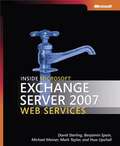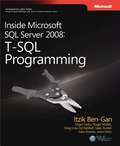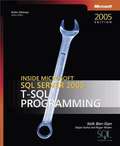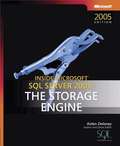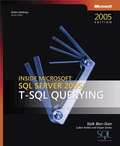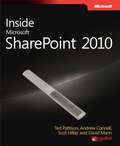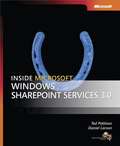- Table View
- List View
Inside Cyber Warfare: Mapping the Cyber Underworld (Oreilly And Associate Ser.)
by Jeffrey CarrInside Cyber Warfare provides fascinating and disturbing details on how nations, groups, and individuals throughout the world use the Internet as an attack platform to gain military, political, and economic advantages over their adversaries. The second edition goes beyond the headlines of attention-grabbing DDoS attacks and takes a deep look inside recent cyber-conflicts, including the use of Stuxnet. It also includes a Forward by Secretary Michael Chertoff and a guest essay by Melissa Hathaway, among others.
Inside Cyber Warfare: Mapping the Cyber Underworld (Oreilly And Associate Ser.)
by Jeffrey CarrWhat people are saying about Inside Cyber Warfare"The necessary handbook for the 21st century."--Lewis Shepherd, Chief Tech Officer and Senior Fellow, Microsoft Institute for Advanced Technology in Governments"A must-read for policy makers and leaders who need to understand the big-picture landscape of cyber war."--Jim Stogdill, CTO, Mission Services AccentureYou may have heard about "cyber warfare" in the news, but do you really know what it is? This book provides fascinating and disturbing details on how nations, groups, and individuals throughout the world are using the Internet as an attack platform to gain military, political, and economic advantages over their adversaries. You'll learn how sophisticated hackers working on behalf of states or organized crime patiently play a high-stakes game that could target anyone, regardless of affiliation or nationality.Inside Cyber Warfare goes beyond the headlines of attention-grabbing DDoS attacks and takes a deep look inside multiple cyber-conflicts that occurred from 2002 through summer 2009.Learn how cyber attacks are waged in open conflicts, including recent hostilities between Russia and Georgia, and Israel and PalestineDiscover why Twitter, Facebook, LiveJournal, Vkontakte, and other sites on the social web are mined by the intelligence services of many nationsRead about China's commitment to penetrate the networks of its technologically superior adversaries as a matter of national survivalFind out why many attacks originate from servers in the United States, and who's responsibleLearn how hackers are "weaponizing" malware to attack vulnerabilities at the application level
Inside Cyber: How AI, 5G, IoT, and Quantum Computing Will Transform Privacy and Our Security
by Chuck BrooksDiscover how to navigate the intersection of tech, cybersecurity, and commerce In an era where technological innovation evolves at an exponential rate, Inside Cyber: How AI, 5G, and Quantum Computing Will Transform Privacy and Our Security by Chuck Brooks emerges as a critical roadmap for understanding and leveraging the next wave of tech advancements. Brooks, a renowned executive and consultant, breaks down complex technological trends into digestible insights, offering a deep dive into how emerging technologies will shape the future of industry and society. In the book, you'll: Gain clear, accessible explanations of cutting-edge technologies such as AI, blockchain, and quantum computing, and their impact on the business world Learn how to navigate the cybersecurity landscape, safeguarding your business against the vulnerabilities introduced by rapid technological progress Uncover the opportunities that technological advancements present for disrupting traditional industries and creating new value Perfect for entrepreneurs, executives, technology professionals, and anyone interested in the intersection of tech and business, Inside Cyber equips you with the knowledge to lead in the digital age. Embrace the future confidently with this indispensable guide.
Inside Deep Learning: Math, Algorithms, Models
by Edward RaffJourney through the theory and practice of modern deep learning, and apply innovative techniques to solve everyday data problems.In Inside Deep Learning, you will learn how to: Implement deep learning with PyTorch Select the right deep learning components Train and evaluate a deep learning model Fine tune deep learning models to maximize performance Understand deep learning terminology Adapt existing PyTorch code to solve new problems Inside Deep Learning is an accessible guide to implementing deep learning with the PyTorch framework. It demystifies complex deep learning concepts and teaches you to understand the vocabulary of deep learning so you can keep pace in a rapidly evolving field. No detail is skipped—you&’ll dive into math, theory, and practical applications. Everything is clearly explained in plain English. About the technology Deep learning doesn&’t have to be a black box! Knowing how your models and algorithms actually work gives you greater control over your results. And you don&’t have to be a mathematics expert or a senior data scientist to grasp what&’s going on inside a deep learning system. This book gives you the practical insight you need to understand and explain your work with confidence. About the book Inside Deep Learning illuminates the inner workings of deep learning algorithms in a way that even machine learning novices can understand. You&’ll explore deep learning concepts and tools through plain language explanations, annotated code, and dozens of instantly useful PyTorch examples. Each type of neural network is clearly presented without complex math, and every solution in this book can run using readily available GPU hardware! What's inside Select the right deep learning components Train and evaluate a deep learning model Fine tune deep learning models to maximize performance Understand deep learning terminology About the reader For Python programmers with basic machine learning skills. About the author Edward Raff is a Chief Scientist at Booz Allen Hamilton, and the author of the JSAT machine learning library. Table of Contents PART 1 FOUNDATIONAL METHODS 1 The mechanics of learning 2 Fully connected networks 3 Convolutional neural networks 4 Recurrent neural networks 5 Modern training techniques 6 Common design building blocks PART 2 BUILDING ADVANCED NETWORKS 7 Autoencoding and self-supervision 8 Object detection 9 Generative adversarial networks 10 Attention mechanisms 11 Sequence-to-sequence 12 Network design alternatives to RNNs 13 Transfer learning 14 Advanced building blocks
Inside IBM: Lessons of a Corporate Culture in Action
by James W. CortadaIBM was the world’s leading provider of information technologies for much of the twentieth century. What made it so successful for such a long time, and what lessons can this iconic corporation teach present-day enterprises?James W. Cortada—a business historian who worked at IBM for many years—pinpoints the crucial role of IBM’s corporate culture. He provides an inside look at how this culture emerged and evolved over the course of nearly a century, bringing together the perspectives of employees, executives, and customers around the world. Through a series of case studies, Inside IBM explores the practices that built and reinforced organizational culture, including training of managers, employee benefits, company rituals, and the role of humor. It also considers the importance of material culture, such as coffee mugs and lapel pins.Cortada argues that IBM’s corporate culture aligned with its business imperatives for most of its history, allowing it to operate with a variety of stakeholders in mind and not simply prioritize stockholders. He identifies key lessons that managers can learn from IBM’s experience and apply in their own organizations today. This engaging and deeply researched book holds many insights for business historians, executives and managers concerned with stakeholder relations, professionals interested in corporate culture, and IBMers.
Inside Internet Security: What Hackers Don't Want You To Know
by Jeff CrumeThis book describes the underlying principles that crop up again and again in hacker attacks, and then focusses on lessons that can be learned, and on how to protect against recurrence. It is a practical reference book for anyone designing or administering a corporate or eBusiness network which runs across a number of platforms via the Internet. It aims to arm systems administrators with a thorough understanding of the problems of network security and their solutions, and thus help realize the tremendous potential of eBusiness. *practical hands-on advice on securing network systems *security checklists for each scenario *detailed pointers to other detailed information sources *in-depth theoretical background information *Multi-platform coverage *Unique external source of info on IBM systems *Wide use of diagrams and illustrations
Inside Jobs: Why Insider Risk Is the Biggest Cyber Threat You Can't Ignore
by Joe Payne Jadee Hanson Mark WojtasiakFrom data security company Code42, Inside Jobs offers companies of all sizes a new way to secure today&’s collaborative cultures—one that works without compromising sensitive company data or slowing business down. Authors Joe Payne, Jadee Hanson, and Mark Wojtasiak, seasoned veterans in the cybersecurity space, provide a top-down and bottom-up picture of the rewards and perils involved in running and securing organizations focused on rapid, iterative, and collaborative innovation. Modern day data security can no longer be accomplished by &“Big Brother&” forms of monitoring or traditional prevention solutions that rely solely on classification and blocking systems. These technologies frustrate employees, impede collaboration, and force productivity work-arounds that risk the very data you need to secure. They provide the illusion that your trade secrets, customer lists, patents, and other intellectual property are protected. That couldn&’t be farther from the truth, as insider threats continue to grow. These include: Well-intentioned employees inadvertently sharing proprietary dataDeparting employees taking your trade secrets with them to the competitionA high-risk employee moving source code to an unsanctioned cloud service What&’s the solution? It&’s not the hunt for hooded, malicious wrongdoers that you might expect. The new world of data security is built on security acting as an ally versus an adversary. It assumes positive intent, creates organizational transparency, establishes acceptable data use policies, increases security awareness, and provides ongoing training. Whether you are a CEO, CIO, CISO, CHRO, general counsel, or business leader, this book will help you understand the important role you have to play in securing the collaborative cultures of the future.
Inside Lightroom 2: The serious photographer's guide to Lightroom efficiency
by Richard EarneyIf you're comfortable using the basic features of Lightroom, but really want to push the envelope with this powerful software, 'Inside Lightroom' by acclaimed photographer and Lightroom Beta-tester Richard Earney is a must-have. Bypassing the obvious features covered in a variety of existing Lightroom books, Richard focuses on customizing Lightroom to suit your workflow. For example, he covers using presets to automate the way Lightroom deals with photos, optimizing your Lightroom workflow for your own hardware and preferences. He covers sophisticated calibration techniques, helping you render your pictures accurately both onscreen and in print. Basically -- the hidden information for this powerful software. Unlike the other 'guides' on the market, this book doesn't tell you what you already know. Instead, it focuses on what you don't.'Inside Lightroom' also showcases the brand-new features of the software, available only in Lightroom 2.0, so if you have recently upgraded from Lightroom 1, this book will help you reap the benefits of your investment. Practical, jargon-free and full of stunning images, Richard Earney's book should be on the shelf of every Lightroom user.
Inside Mathforum.org: Analysis of an Internet-Based Education Community (Learning in Doing: Social, Cognitive and Computational Perspectives)
by Wesley ShumarThe internet has dramatically transformed social space and time for many people in many different contexts. This dramatic warping of the social fabric has happened slowly over time as digital technologies have evolved and internet speeds have increased. While we are all aware of these changes, the impact is often little understood. There are few monographs about social groups made possible by the internet, and even fewer about educational communities made possible through digital technologies. Inside Mathforum. org details the ways that digital media are used to enhance the practices that teachers and students of mathematics engage in. The book also shows how different kinds of mathematical conversations and interactions become possible through the digital media. Unlike many other educational uses of digital media, the Math Forum's community has provided online resources and sustained support for teachers and students, and it leads the way in showing the power of digital media for education.
Inside Microsoft Dynamics® AX 2009
by Lars Dragheim Olsen Michael Fruergaard Pontoppidan Hans Jorgen Skovgaard Deepak Kumar Satish Thomas Tom KaminskiDig into the architecture and internals of Microsoft Dynamics AX--with firsthand insights from the team who designed and developed it. Deepen your knowledge of the underlying frameworks, components, and tools--and get best-practice guidance to customize and extend your own high-performance solutions. Discover how to: Work with MorphX application-modeling tools and X++ code Exploit built-in workflow infrastructure to simplify process automation Use Enterprise Portal and ASP.NET to build rich, role-based Web portals See how reporting components work together for better business intelligence Execute complex batch jobs with greater control and reliability Learn how the runtime implements configuration and security Walk through integration scenarios and technologies Create and expose services to external applications Optimize application performance and extensibility
Inside Microsoft Dynamics® AX 2012
by The Microsoft Dynamics AX Team<p>Dig into the architecture and internals of Microsoft Dynamics AX 2012—guided by the team that designed and developed it. Deepen your knowledge of the underlying frameworks, components, and tools—and design high-performance solutions.</p>
Inside Microsoft Dynamics™ AX 4.0
by Arthur Greef Michael Fruergaard PontoppidanTake a detailed look at the internal architecture of Microsoft Dynamics AX 4.0 with this comprehensive reference for developers and IT implementers. Architects from the Microsoft Dynamics AX team take you deep inside the application frameworks and the development environment. You'll get expert insights to help you master the intricacies of planning, programming, and maintaining adaptable enterprise resource planning solutions. Discover how to: Use MorphX designers and development tools Work with the X++ programming language Build managed solutions that enable enterprise application integration Customize tables, classes, forms, and reports Develop and customize role-based, Web-enabled application portals Implement applications that concurrently support multiple users, languages, and locations Query application metadata using reflection APIs Design and implement application logic that optimizes database performancePlus--Get code samples on the Web
Inside Microsoft SharePoint 2013
by Ted Pattison Andrew Connell Scot Hillier Mirjam Van Olst Kyle Davis Wictor WilenBuild custom SharePoint solutions with architectural insights from the experts. Take a deep dive into SharePoint 2013, and master the intricacies for designing and implementing robust apps and other business solutions for your organization. Led by an author team with in-depth knowledge of SharePoint architecture, you'll thoroughly explore the SharePoint 2013 development platform and new app model through hands-on tasks and extensive code samples. Discover how to: Create SharePoint-hosted, provider-hosted, and autohosted apps Master the new app security model with OAuth and Certificates Develop workflows with the SharePoint 2013 workflow model Design a custom search experience and create search-based apps Leverage the client-side object model and REST APIs Produce catalog-driven web sites with Web Content Management capabilities Get cloud-based data sources with Business Connectivity Services Create and utilize remote event receivers for lists and libraries Generate new social networking apps and solutions
Inside Microsoft Windows SharePoint Services 3.0
by Daniel Larson Ted Pattison<div xmlns="http://www.w3.org/1999/xhtml"><p>Get deep insights into Windows SharePoint Services 3.0 with this hands-on guide. You get a bottom-up view of the platform architecture and task-oriented guidance for building applications. Includes code samples in Microsoft Visual C#\xae and XML.</p></div>
Inside Microsoft® Exchange Server 2007 Web Services
by Mark Taylor David Sterling Michael Mainer Ben Spain Huw UpshallDive deep into the architecture of Exchange Web Services--and master the intricacies for accessing data with the new, unifying API. Exchange Web Services offers new functionality, replacing old, disparate APIs. Written by members of the Microsoft Exchange Server 2007 and Exchange Web Services product teams at Microsoft, this practical guide introduces developers to Exchange Web Services. It includes comprehensive, in-depth coverage of the architecture and key features, including messaging, folders, calendaring, tasks, notifications, searching, availability, and autodiscovery. Developers who are moving applications using previous APIs to Exchange Web Services will learn how to determine the correct Web services constructs--and the implications of those decisions. In addition, developers writing new software will develop a well-grounded understanding of the methods available and how to structure interaction with Exchange Server 2007 for maximum benefit and performance. This book assumes only knowledge of how to write HTTP requests, but it provides proxy examples in Microsoft Visual C#®.
Inside Microsoft® SQL Server® 2008: T-SQL Programming
by Dejan Sarka Itzik Ben-Gan Roger Wolter Greg Low Ed Katibah Isaac KunenGet a detailed look at the internal architecture of T-SQL with this comprehensive programming reference. Database developers and administrators get best practices, expert techniques, and code samples to master the intricacies of this programming language--solving complex problems with real-world solutions. Discover how to: Work with T-SQL and CLR user-defined functions, stored procedures, and triggers. Handle transactions, concurrency, and error handling. Efficiently use temporary objects, including temporary tables, table variables, and table expressions. Evaluate when to use set-based programming techniques and when to use cursors. Work with dynamic SQL in an efficient and secure manner. Treat date- and time-related data in a robust manner. Develop CLR user-defined types and learn about temporal support in the relational model. Use XML and XQuery and implement a dynamic schema solution. Work with spatial data using the new geometry and geography types and spatial indexes. Track access and changes to data using extended events, SQL Server Audit, change tracking, and change data capture. Use Service Broker for controlled asynchronous processing in database applications. All the book's code samples will be available for download from the companion Web site.
Inside Microsoft® SQL Server® 2008: T-SQL Querying
by Dejan Sarka Itzik Ben-Gan Lubor Kollar Steve KassTackle the toughest set-based querying and query tuning problems--guided by an author team with in-depth, inside knowledge of T-SQL. Deepen your understanding of architecture and internals--and gain practical approaches and advanced techniques to optimize your code's performance. Discover how to: Move from procedural programming to the language of sets and logic Optimize query tuning with a top-down methodology Assess algorithmic complexity to predict performance Compare data-aggregation techniques, including new grouping sets Manage data modification--insert, delete, update, merge--for performance Write more efficient queries against partitioned tables Work with graphs, trees, hierarchies, and recursive queries Plus--Use pure-logic puzzles to sharpen your problem-solving skills
Inside Microsoft® SQL Server™ 2005
by Dejan Sarka Itzik Ben-Gan Lubor KollarGet a detailed look at the internal architecture of T-SQL with this comprehensive programming reference. Database developers and administrators get best practices, expert techniques, and code samples to master the intricacies of the programming language--solving complex problems with real-world solutions. Discover how to: Understand when to apply set-based programming techniques Design and implement date and time-related XML and CLR datatypes Use temporary objects, including temporary tables, table variables, and table expressions Work with T-SQL and CLR user-defined functions, stored procedures, and triggers Support user input-based queries and variable data with dynamic execution Work with transactions and new exception handling constructs Apply a concurrency model to support simultaneous users Use Service Broker for controlled asynchronous processing in database applications This book includes code samples on the Web.
Inside Microsoft® SQL Server™ 2005
by Kalen DelaneyTake an in-depth look at the internals of the SQL Server Storage Engine--with advice from a popular author and SQL Server expert. Database developers and administrators get best practices, pragmatic advice, and code samples to help master the intricacies of creating and maintaining enterprise relational databases. Discover how to: Upgrade or migrate to SQL Server 2005 and choose configuration options Control space allocation for databases and files manually or automatically Manage transaction logs to maximize efficient restore operations and data consistency Observe the internal structures of clustered and nonclustered indexes Build and partition relational indexes and tables Explore internal storage issues and compare fixed- and variable-length datatypes Detect and correct index fragmentation Implement and manage an appropriate concurrency model using locking or row versioning PLUS--Get code samples on the Web.
Inside Microsoft® SQL Server™ 2005: T-SQL Programming
by Dejan Sarka Itzik Ben-Gan Roger Wolter<div xmlns="http://www.w3.org/1999/xhtml"><p>A comprehensive, hands-on reference for database developers and administrators, this book focuses on advanced language features of Transact-SQL (T-SQL), the database programming language built into SQL Server. Includes code and table examples.</p></div>
Inside Microsoft® SQL Server™ 2005: T-SQL Querying
by Dejan Sarka Itzik Ben-Gan Lubor KollarTake a detailed look at the internal architecture of T-SQL--and unveil the power of set-based querying--with comprehensive reference and advice from the experts. Database developers and administrators get best practices, sample databases, and code to master the intricacies of the programming language--solving complex problems with real-world solutions. Discover how to: Understand logical and physical query processing Apply a methodology to optimize query tuning Solve relational division problems Use CTEs and ranking functions to simplify and optimize solutions Aggregate data with various techniques, including tiebreakers, pivoting, histograms, and grouping factors Use the TOP option in a query to modify data Query specialized data structures with recursive logic, materialized path, or nested sets solutions PLUS--Improve your logic and get to the heart of querying problems with logic puzzles Get code and database samples on the Web
Inside Microsoft® SQL Server™ 2005: The Storage Engine
by Kalen DelaneyUnderstanding the internals of storage in SQL Server helps database developers and administrators to better create, maintain, and mine information from enterprise data. This practical, hands-on book focuses on the SQL Server 2005 Storage Engine and delves deep into the structures used for storing data, including files, tables, indexes, and data types. Topics also include security details, with coverage of the new SQL Server 2005 security model, and data protection through the backup and restore algorithms. With pragmatic advice, best practices, extensive code samples, and table examples, developers and database administrators will find the guidance they need to better understand how to build powerful, efficient databases.
Inside Microsoft® SharePoint® 2010
by Ted Pattison Andrew Connell Scot Hillier David Mann<p>Get a detailed look inside SharePoint 2010—and master the intricacies of developing intranets, extranets, and Web-based applications. Guided by an author team with in-depth knowledge of SharePoint architecture, you'll gain task-oriented guidance and extensive code samples to help you build robust business solutions.</p>
Inside Microsoft® Windows® SharePoint® Services 3.0
by Daniel Larson Ted PattisonFocus in on the internals of the Windows SharePoint Services 3.0 platform with this in-depth, straightforward reference. You get expert insights, task-oriented guidance, and extensive code samples to help you master the intricacies of building robust, enterprise content management applications. Discover how to: Build application pages and site pages Develop and deploy reusable Web parts to enable customization and personalization Exploit Windows SharePoint APIs to deploy Microsoft ASP.NET AJAX components Use XML and Collaborative Application Markup Language (CAML) to create provisioning components Design and implement custom document libraries Use Windows Workflow Foundation to create applications that automate business process Create Site Definitions to aggregate components and package them for deployment Implement Code Access Security, Trust Levels, authentication, and authorization PLUS--Get Microsoft Visual C# and XML code samples on the Web
Inside Multi-Media Case Based Instruction
by Roger C. SchankThe fourth in the Inside series, this volume includes four theses completed under the editor's direction at the Institute for the Learning Sciences at Northwestern University. This series bridges the gap between Schank's books introducing (for a popular audience) the theories behind his work in artificial intelligence (AI) and the many articles and books written by Schank and other AI researchers for their colleagues and students. The series will be of interest to graduate students in AI and professionals in other academic fields who seek the retraining necessary to join the AI effort or to understand it at the professional level. This volume elaborates the Case-Based Teaching Architecture. A central tenet of this architecture is the importance of acquiring cases, and being able to retrieve and use those cases to solve new problems. The theses address the problems of building case bases, indexing large amounts of data contained within those case bases, and retrieving information on a need-to-know basis. They also reflect the work of researchers at the Institute to design tools that enable software programs to be built more effectively and efficiently.
